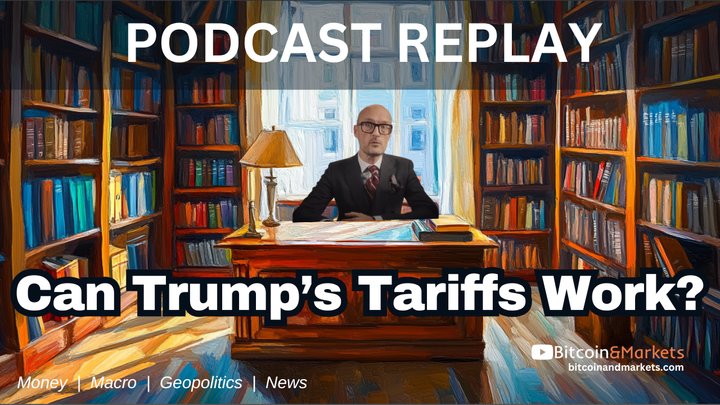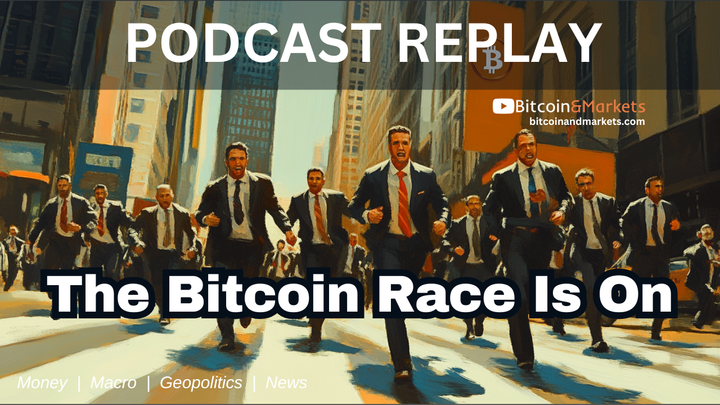The Case for Deflation: Part 2 - E212
Different types of money, debt, fiat and commodity monies and how they behave differently as a global money standard.

In this episode I tackle different types of money, debt, fiat and commodity monies. I discuss how they behave differently as a global money standard. Debt has a unique aspect of global deflation that’s not shared with other forms of money. I discuss bailouts at money replacement, not money expansion. Finally, I wrap up with how this all ends.
Get The Bitcoin Dictionary!
Bitcoin jargon demystified. Over 180 Bitcoin terms, concepts, and idioms.
bitcoindictionary.cc
The TOP Free Bitcoin Newsletter!
Don't miss another issue. Subscribe to the Free tier!
Subscribe to the Pod!
iTunes | Stitcher | Google Pods | YouTube | Soundcloud | RSS
The Show Needs Your Support
We’re a small operation and producing quality content people find valuable.
Check out our big list of ways to help the show
Affiliates
- Chart Like A Pro With TRADINGVIEW
- The Best WordPress Theme I’ve Ever Used! GeneratePress
- Sign Up For Audible And Get 2 FREE Audio Books
Have Feedback? Send it our way.
**DISCLAIMER: This is not investment advice, do your own research.**
Transcript
by Bradley Stone
Introduction
Hello bitcoiners, I’m back with another episode. This is going to be part two of The Case for Deflation. It’s like my strong dollar thesis here.
Part One, we went over a definition of inflation, that it is an expansion of the money supply and that inevitably leads to increase in prices. Remember Misa said it inevitably leads to an increase in prices. So deflation would be the reverse of that, that a contraction in the money supply that inevitably leads to decreases in prices. At the end of that episode, I left you with a question: If prices have to increase with money expansion, and we aren’t seeing price increases, do we have money expansion or inflation? Do we need to revisit what we think of as money? Or does the money that we use today follow the same principles as commodity money or fiat money?
That’s what I want to do in this episode. I want to take a look at these different types of money, because I think that will help us work through this “strong dollar” deflationary argument. So there’s three types of money.
The Three Types of Money
You probably know this is debt money, fiat money, and commodity money. So debt-based money is money issuance that has a corresponding debt. It’s created by banks when they make loans or they lend money. That’s conjured money, but it has a corresponding debt attached to it. “Fiat” money is conjured money, but it has no corresponding debt. Another telltale sign of fiat money is legal tender. When you see the term “legal tender”, that’s fiat money.
And then there’s “commodity” money, and that’s gold, Bitcoin, silver — these are real commodities. Commodity money is what arises in a market naturally, while fiat is government money. “Debt” money would be government or bank money.
For the last 300 years, we’ve had a spectrum — We didn’t have pure fiat because it had a gold backing. So it’s commodity money with a fiat attached, making it legal tender, but it was also a fractional reserve. So there was debt. That’s debt money, fiat money and commodity money all rolled into one, and it was the Central Bank standard for the last 300 years.
Of course, we have booms and busts within that (the business cycle). In 1971, we went off the gold standard. We had a global dollar standard after World War II. With Bretton Woods, dollars were sent all around the world and entrenched in the plumbing of the global economy.
In 1971, we went off the gold standard, so this was the first time ever that there was a global debt base standard. It had been tried in isolated economies, and it always ended with inflation. But that was the first time it had been global. It’s a completely different system. You can think of it this way:
Under a gold standard, say an economy has a million ounces of gold, and then they strike a deposit or something like that. The money supply inflates to 2 million ounces of gold, prices will go up, and there’ll be an inflationary boom followed by a bust. It won’t be a deflationary bust because that gold is still there — there’s still 2 million ounces. Now you could say the gold will leave the country, but it goes somewhere else and somewhere else experiences inflation, so someone’s deflation is someone else’s inflation in that scenario.
But the global net is no deflation. Deflation does not happen globally, but with a debt-based system (the dollar system around the globe), the net total is deflation, drastic deflation. So it’s a completely different animal when you’re talking about a global economy versus an individual economy. We have a global dollar system that the Fed is not central to — The Fed is a domestic banking authority.
We also need to think about debt issuance. When debt is issued or money is created in a debt based system, new assets are also created (because that loan is an asset for somebody). It’s a financial product, but it’s also an asset. Then it can be bundled, securitized, have derivatives and be sold off. So the amount of goods in the economy, even though they are financial products, expands faster than the amount of money that is created. And so this ratio is constantly being out of whack to the deflationary, price-decline side.
Some of that can be stuck in the financial system, and that’s why we see financial product prices going up — it’s inflation in that little pocket. But net-wise, it’s net deflationary to do that because you create more products from that money to chase.
It’s at least a one-to-one ratio, right?
That’s why we see CPI having very low inflation while they’re constantly fighting to keep the symmetrical inflation target of 2%. If it’s under that, they have a hard time keeping it high because the inflation is stuck in the financial products. When that deflates, it destroys the money. It’s actual deflation, and it’s a different animal.
Now, let’s talk about bailouts. Bailouts are a replacement, not an expansion of the money supply. Think of it like a paper note replacement: After a few years, the paper notes like US dollars get worn out. They are sent to the Fed, the Fed destroys them, then prints new replacements. Is that increasing the money supply? No, it’s a replacement of the money supply.
Say we have a deflation event, where 100 billion dollars is being destroyed through defaults, then the Fed, the government, or somebody else prints 100 billion dollars to plug that hole and replace that money supply. That’s not technically an increase in the monetary base or the money supply, but you could say that expansion wouldn’t have happened in the free market.
You should just let people fail. This is not an endorsement of this system, but I would counter and say that with gold, the net is not deflation. On a global scale, gold will stay there. Gold will not be destroyed by a default. With a debt based system, money is destroyed on a global scale. That would be the counter-argument, that it’s extremely destructive.
Having a debt-based standard is extremely destructive in both ways — The boom and the bust. A gold standard or a Bitcoin standard would be better, but I’m pointing out the differences. There are limitations of the system we have and I’m trying to understand it.
Bailouts are replacement. They mimic a gold standard because gold does not get destroyed. This ends eventually in deflation, it does not end in inflation. A global debt standard cannot end in inflation, because people will lose confidence in the debt. People say, “Oh, they lose confidence. They’ll just print, print, print, and they’ll lose confidence.” But they don’t lose confidence in a smooth way: Confidence is lost, but it’s binary. That’s why you can’t debase debt. It’s a unit of debt, and either it’s good or it’s bad. You can’t be debt-based and confidence will not be lost slowly. But the reality is confidence will be lost all at once, that’s why we see these big things in the repo market in September. Confidence was lost and the market freezes, people default and there’s hyper-deflation.
It’s an emergency deflation.
So the end of the system is not a slow inflation or even a runaway inflation of prices, with increasing money supply and prices going up. Instead, this happened. This ends in a big freeze, massive default, and massive deflation. To stop this, we need to create a whole new system. You can just let it fail, but that’s massive pain. And it will be avoided. I’m not saying that it can be avoided, but it will be avoided at all costs.
Does that mean you just keep printing and replacing this bad money with new money? Yeah, pretty much. That’s what’s going to happen until there’s a Bretton Woods type of agreement, and they slowly try to wean themselves off and towards a CBDC, or back to gold. They probably won’t go back to gold, but probably to a CBDC, because they don’t understand what’s happening either. They just know if they let it deflate, everything will be destroyed.
That’s it for this one. In the next episode, we’re going to talk about liquidity, the big freeze, and why that happens. We saw it in the repo markets, we have seen it happen over and over again. I’m going to talk about the plumbing as well as I can, but I’ve covered the meat of my argument. I’ll explain more in the liquidity section. Thanks, guys for listening. We’ll see you next time.




